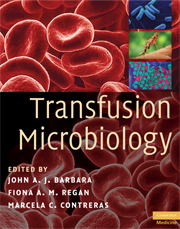Book contents
- Frontmatter
- Contents
- List of contributors
- Foreword
- Preface
- Acknowledgements
- Glossary
- Introduction: Transfusion-transmitted infections, then and now
- Section 1 Agents
- Section 2 Selection and testing
- 10 Blood donor selection and qualification
- 11 Current serological methods of testing and automation
- 12 Confirmatory testing and donor re-admission
- 13 The strategy for applications of nucleic acid testing
- 14 Nucleic acid testing: general view
- 15 Nucleic acid testing: the US approach
- 16 Nucleic acid testing: the UK approach
- 17 Quality in the screening of donations for transfusion-transmissible infections
- 18 Microbiological blood testing and new technologies
- 19 Processing and components: leucodepletion and pathogen reduction
- 20 Fractionated products
- Section 3 Surveillance, risk and regulation
- Index
- Plate section
- References
11 - Current serological methods of testing and automation
from Section 2 - Selection and testing
Published online by Cambridge University Press: 12 January 2010
- Frontmatter
- Contents
- List of contributors
- Foreword
- Preface
- Acknowledgements
- Glossary
- Introduction: Transfusion-transmitted infections, then and now
- Section 1 Agents
- Section 2 Selection and testing
- 10 Blood donor selection and qualification
- 11 Current serological methods of testing and automation
- 12 Confirmatory testing and donor re-admission
- 13 The strategy for applications of nucleic acid testing
- 14 Nucleic acid testing: general view
- 15 Nucleic acid testing: the US approach
- 16 Nucleic acid testing: the UK approach
- 17 Quality in the screening of donations for transfusion-transmissible infections
- 18 Microbiological blood testing and new technologies
- 19 Processing and components: leucodepletion and pathogen reduction
- 20 Fractionated products
- Section 3 Surveillance, risk and regulation
- Index
- Plate section
- References
Summary
Introduction and history
Despite the increasing importance of nucleic acid testing (NAT) for the direct detection of viraemia, the main methods of testing blood donors for evidence of infection continue to rely on detection of antigens produced by pathogens or antibodies raised against them. From the earliest cardiolipin tests for syphilis, introduced before the Second World War, to the most modern and sophisticated automated systems, this principle has not changed. The first viral marker to be conclusively associated with transfusion-transmitted infection was the so-called Australia antigen, now called HBsAg (Blumberg et al., 1965). Within five years of publication of his findings, most major blood centres, at least in the developed world, were routinely screening donations for this marker. The earliest tests were immuno-diffusion and counter immuno-electro-osmopheresis (CIEOP). Poor specificity and sensitivity, along with the continued inability to culture hepatitis-causing viruses in the laboratory, led to the development of increasingly sophisticated and sensitive tests, ranging from haemagglutination assays to solid phase radiometric assays. The development of EIA (enzyme linked immuno-sorbent assay) by Engvall and Perlmann (1971) and Van Weemen and Schuurs (1971) laid the foundation for modern test methods, allowing for development of assays that could be automated, and facilitating compliance with GMP (good manufacturing practice), the foundation of the quality and regulatory systems used by many countries to ensure the highest quality of test performance.
- Type
- Chapter
- Information
- Transfusion Microbiology , pp. 159 - 172Publisher: Cambridge University PressPrint publication year: 2008



